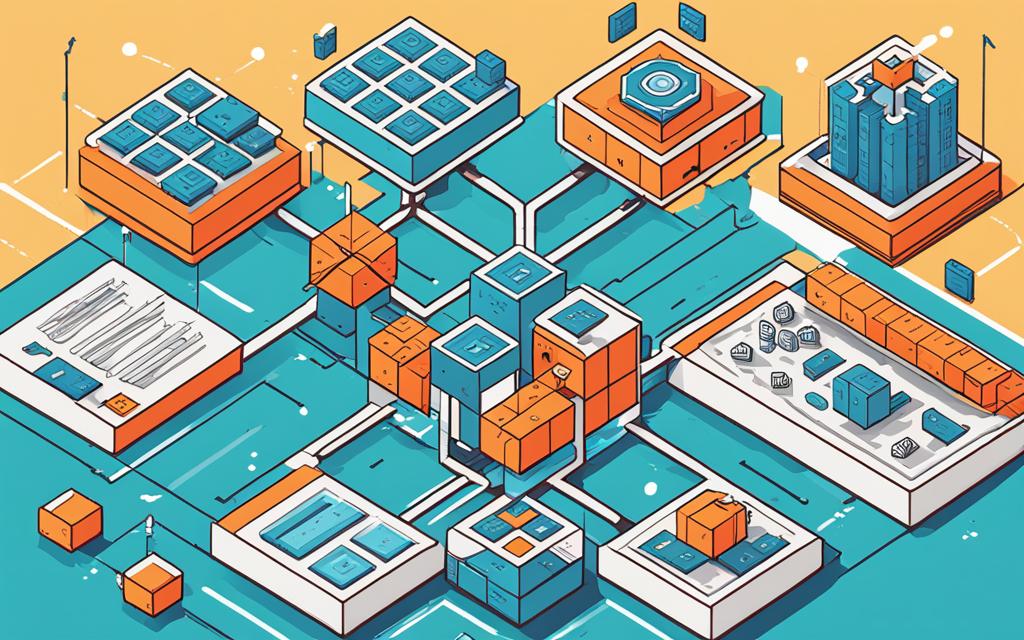Table of Contents
A modular blockchain is changing the game in technology. It solves problems traditional blockchains have by being flexible and efficient. Unlike old blockchains that do everything on one chain, modular blockchains have specific parts for tasks like settlement and data. This makes them work better and lets us make them fit what we need1. People are trying new ways, like sharding and layer 2, to make blockchain handle lots of users and data1. This modular way helps make blockchain systems work even better, bringing big improvements.
The big issue with old blockchains is they are hard to make work well with lots of people and tasks. They need a lot of powerful machines, complex steps to start, and don’t allow much change once they’re running1. But with a modular design, blockchain can be more efficient, grow easier, and stay safe1. Modular blockchains let developers fine-tune each part, making everything run smoother2. This means developers can make blockchains that fit exactly what people and businesses need3.
Modular blockchains split tasks into layers, like execution, settlement, and data management. Developers can work on each part separately, making the whole system better2. For instance, rollups focus on fast processing, while platforms like Celestia handle making sure everyone agrees on what’s true. This lets developers pick and choose the best tools for the job, making blockchains work really well for their purpose3.
Key Takeaways:
- Modular blockchains focus on specific tasks, making them more scalable and adaptable1.
- Using a modular design makes blockchains work better, grow easily, and stay secure1.
- By splitting tasks, developers can make every part of a blockchain more effective2.
- This design gives developers freedom to make blockchains that meet exact needs3.
- Moving from old blockchains to modular ones marks a big step towards highly effective blockchains1.
Blockchain technology is quickly advancing, and modular blockchains are leading the way. Understanding how modular blockchains work can help developers, investors, and users alike. It brings better scalability, efficiency, and flexibility. This is the start of something big in the tech world.
The Framework of Modular Blockchains
There’s a new way revolutionising how we think about cryptocurrency. It’s called modular blockchains. These blockchains change the game with their flexible and scalable design. Instead of one big system, they break into smaller parts that do specific jobs well. This makes everything run smoothly together.
Each part of a modular blockchain tackles a key task like making things happen, settling transactions, agreeing on what’s true, or making data available. This focus helps them process information better and handle more actions at once. It’s an answer to the problems bigger systems face. By being smart about how they work and getting each part right, they boost speed and overall performance.
The framework includes blockchains made for certain jobs. These single-purpose blockchains work on their own bit but join forces to scale up and customise the system. For instance, rollups are all about making things happen, while Celestia oversees and shares what’s true in rollups. This lets developers fit the system to exactly what they need and update parts easily, making the whole thing more useful and open to new ideas4.
Benefits of Modular Blockchains
For those developing and using them, modular blockchains bring lots of good stuff. Their smart design and focused tasks help with:
- Scalability: Splitting everything into layers helps them grow and work better than all-in-one systems5.
- Affordability: Doing more with less power cuts down on costs, making things cheaper all around4.
- Security: By making sure every part is safe and follows a set of rules, modular blockchains dodge many bad security situations45.
- Innovation: Updating and trying new things easily makes for a more creative, lively blockchain world4.
- Flexibility: You can mix and match the blockchains to suit different projects and goals4.
Modular blockchains offer huge benefits but also face big challenges. They can do more but need careful handling to stay safe and grow well45. Developers and users need to be smart about this to build reliable, flexible systems we can trust.
Monolithic vs. Modular Blockchains
Monolithic blockchains were the first type created. They put all functions in one layer, called L16. This early method laid the ground for blockchain networks. But, it runs into trouble as more people use it. The mix of functions in one layer slows down when many transactions happen76. The system simply can’t keep up.
Now, modular blockchains are seen as a better way. They split the tasks into different layers. You have layers for execution, agreement, settlement, and data. This setup lets each part grow almost on its own. It speeds up how many transactions can go through and lowers delays87.
These modular blockchains can be fine-tuned. Each layer is made just for its job without affecting the others7. This means they can get better at doing what they do. They can also change and improve quicker than a single-layer monolithic model that’s all or nothing when it comes to upgrades7.
Monolithic blockchains try to be good at everything. They aim for wide use and for covering all tasks. But, this makes them not very good at dealing with growth, being flexible, or keeping both secure and open86. In comparison, modular blockchains work differently. They focus on having separate layers for each job, which makes them better for growth and uses8.
In the end, while monolithic blockchains can have problems with how well they scale and with the trade-off between safety and openness, modular blockchains do better. By breaking tasks into specialized layers, modular designs bring more room to grow and to adapt. They mark a step forward in blockchain tech87.
Benefits of Modular Blockchains
Modular blockchains bring many advantages. They are perfect for those looking for scalable, affordable, and secure systems. Businesses and developers find them innovative and flexible too.
- Scalability: Modular blockchains are great at growing. They distribute tasks across various chains. This customisation and scalability is key. It deals with the main issue of traditional setups. This design ensures smooth operation for all without fights over resources9.
- Affordability: Their design also means modular blockchains cost less to set up. This factor is a huge plus for startups and smaller ventures10. It helps level the playing field in the blockchain arena.
- Security: In terms of safety, modular blockchains shine. They let developers check and test parts separately11. A shared security model streamlines safety measures, making the entire system stronger9. It brings benefits without compromising on security.
- Innovation: The modularity boosts creativity. It allows for the creation of new, special apps. This freedom to mix various technology stacks encourages new and clever solutions. This widens the options in the decentralized world.
- Flexibility: Modular blockchains are highly adaptable. You can easily change parts to suit different needs. This allows for quick testing and upgrading, keeping the system fit for changing demands.
Clearly, modular blockchains offer a lot. They provide a refreshing alternative to rigid setups. As the digital currency world grows, modular systems are likely to lead the way. They promise a more efficient and safer space for all kinds of digital projects10.
Pros of Modular Blockchains
Modular blockchains have several benefits that are making them more popular. They are known for being scalable, affordable, secure, allowing for innovation, and flexible. This makes them the go-to choice for both businesses and developers wanting to use blockchain technology.
Enhanced Scalability
Modular blockchains solve the problem of limited growth that monolithic blockchains face. How? They spread tasks across many specialised chains. This approach leads to faster deal processing, supporting more transactions without losing the decentralised nature. Plus, methods like rollups and validium have caught on in the blockchain community for their scalability.
Affordability and Cost Reduction
For businesses, modular blockchains mean lower costs in creating and keeping up their blockchain. Developers can work on specific parts, cutting down on time and costs. This happens thanks to the modular design, which speeds up the development process and lessens expenses.
Heightened Security
Security is a big win with modular blockchains, all thanks to their layered structure. Each part can be checked and tested separately by developers. This reduces the chances of major failures. It also means that the built-in security of blockchain tech shines even brighter with modular setups.
Innovation and Flexibility
The building block of innovation is the modular nature of blockchain. It lets developers easily add unique features and apps. Such flexibility is great for businesses, letting them customise their blockchain to meet their exact needs. This opens up new possibilities and pushes the blockchain world further ahead.

Modular blockchains are set to change many industries. They’re popular in finance, supply chains, healthcare, and entertainment for good reasons. The benefits they bring are sparking a lot of interest and are being quickly adopted1213.
Cons of Modular Blockchains
Modular blockchains have many benefits like being easy to grow and change. But, there are also some problems to think about.
Increased Complexity
Implementing a modular blockchain makes things more complex. It lets you mix and match different parts, which can confuse users and developers. They might find it hard to understand and use the whole system at first.
This can lead to needing more training to get used to it. Yet, good learning materials and advice can make dealing with this complexity easier. Over time, it can become simple to manage.
Limited Usability Testing
Modular blockchains face another issue, not enough testing on how well they work. While being able to update parts easily is great, it must be tested thoroughly. Making sure these parts work well together is key for a smooth experience for users.
As technology gets better, doing lots of tests will only become more crucial. This is how we can make sure these networks are easy and safe to use in the long run.
Security Concerns
When it comes to security, modular blockchains need extra care. Since each part’s safety links to the others, if one fails, the whole system might be at risk. It’s important to keep all parts safe and up to date.
This means always checking how secure the network is. Regular updates and checks keep a modular blockchain network a safe place.
Even with these challenges, the upsides of modular blockchains are strong. The ability to become bigger and change easier is very valuable. With enough work on development, testing, and safety, modular blockchains can be a big part of blockchain’s future.
How Modular Blockchains Work
In the world of blockchain tech, modular blockchains are changing how we build. They take a new approach, splitting a blockchain’s core functions into different layers. Each layer does a specific job, like handling execution or settling transactions. By doing this, tasks are spread out across these layers, making the system run better and faster15.
This splitting allows easier improvements and changes to each area. It makes the whole system more flexible. So, developers can build chains that work best for their needs. This is a big jump from older systems like Bitcoin and Ethereum, where everything is put together1512.
There are many good things about modular blockchains. The biggest is how they let you focus on what’s important. This saves time and money and lets you make a system that fits perfectly for you1516. They also help make systems faster and able to handle more things. That’s because each part can focus on doing one thing really well. This design is why systems like Polkadot and Cosmos are doing so well. They let you pick and choose different parts to make your system just right15.
Take Astar Network, for instance. It’s on Polkadot and uses this smart design. It makes use of the safety that Polkadot offers while still being unique. By focusing on what it’s good at, Astar Network becomes great for anyone building apps on it15. So, it shows how well this modern approach can work, giving developers a top-notch place to create.
While many think modular blockchains are the future, there are hurdles to jump. Making sure they’re safe and not too complicated is a big challenge. But the plus sides, like focusing on special tasks and running faster, are too good to ignore. It’s why so many in the tech world see this as an exciting new way to do blockchain stuff16.
Examples of Modular Blockchains
Modular blockchains are changing how we see blockchain. They offer a way to build decentralised apps that’s both flexible and scalable. Two key examples are Celestia and Cosmos.
Celestia
Celestia leads the pack by focusing on creating agreement and sharing data. It uses a smart method. It separates tasks and sends some work to other special blockchains. This makes its system run better and grow easier17.
Cosmos
Cosmos also stands out. It aims for different blockchain networks to work together seamlessly. Cosmos allows for building separate yet connected blockchains. It does this using Zones as sidechains, Hubs as the core chain, and a special way for them to talk, called Inter-Blockchain Communication (IBC)18.
Both Celestia and Cosmos highlight how powerful modular blockchain designs can be. They enhance scalability, flexibility. Making new blockchains is simpler too. This approach helps developers focus and offers a better experience for users1718.
But, there are things to watch out for with modular blockchains. They might face security risks. The design can also get quite complicated. These issues are important to keep in mind when working on them19.
The Data Availability Problem
Modular blockchains face a big problem called data availability. It happens when a block producer doesn’t share the data. This stops other nodes from checking if transactions are real. It puts the system’s trust and safety at risk.
There are ways to deal with this issue. One idea is using erasure coding. It splits the data into parts and spreads it out. Even if some data is missing, the block can still be checked.
Data Availability Sampling (DAS) is another trick. It checks parts of the data, not all. This means less data to download but still making sure it’s all there. It makes things work faster and smoother.
Stateless Ethereum clients are also important. They don’t keep any data, just check it. This makes Ethereum work better and be more flexible20.
Data Availability Committees (DACs) are getting popular too. They’re made of trusted groups who ensure the data is there. By using more than one party, DACs limit the risk of no data being available.
Ethereum takes data availability seriously. It uses special nodes to keep old data. This means all Ethereums’ data is still around. It helps keep the network reliable and honest20.
Layer 2 rollups are a new way to make blockchains faster. They do most work away from the main chain. But they need good, easily reached data to work. This makes data availability key to their success20.
Data Availability in Celestia
Celestia is the first network focused on making transaction data easy to get. It works by separating how work is done and how agreement is reached. This setup makes sure data is always there.
Celestia uses Proof-of-Stake for safety. This allows users to help secure the network by trusting validators. Validators like Chorus One are key to this process21.
Celestia uses ‘data availability sampling’ for better data access without the need to download all data. This saves time and resources for those checking the network21. It also speeds up how new blockchains can be set up and tested21.
Chorus One is an important staking service for many networks, including Ethereum. Their work helps networks run securely and keeps data easy to reach for everyone21. They are well-known for their professional services and support for blockchain research21.
Data Availability and Blockchain Scalability Trilemma
The blockchain trilemma shows the hard choices in blockchain design. It’s tough to be fast, safe, and open at the same time. Scalability’s challenge is to handle many transactions without giving up data security and fairness22.
Bitcoin, for example, is slow compared to newer solutions. It can do about 7 transactions per second (TPS)22. Ethereum’s Layer 2 solutions group many transactions together. This makes the system faster and cheaper22. But, using the main chain too much can slow things down and make them cost more22.
DA layers in rollups aim to fix the trilemma by making data secure and easy to get. They put some data off the main chain. This makes storing data cheaper and helps scalability. Plus, blockchains can keep their data safe and easily checked22.
These DA layers also make it easier for light clients to work off-chain. Nodes don’t need as much storage or data to check the blockchain. This helps keep the network running smoothly and honestly22.
Dealing with the data availability problem is key to solving the blockchain trilemma. It helps make blockchains faster, safer, and more open. This is important for blockchain tech to grow and be used more widely202122.
The Blockchain Scalability Trilemma
The blockchain scalability trilemma is a big issue for blockchains. It’s about balancing decentralization, security, and scalability23. Trying to be big, safe, and spread out all at once is hard. This makes it tough for blockchain experts.
Scalability means how well a blockchain can manage lots of transactions at once. But to get faster, blockchains often lose some of their safety and shared control23. They get quicker by making decisions in one place, which isn’t very spread out. Also, keeping things super safe can slow the system down.
Normal tech often chooses to be quick and cheap instead of spread out. This causes a system to be in charge from one place, making it fast but not always safe like blockchains23. Finding the perfect mix of managing many transactions, being spread out, and staying safe is a big deal for people building new blockchains.
Now, there’s hope with modular blockchains. They aim to be good at managing lots of transactions, being efficient, and staying safe all at once24. By splitting the work and making each part better, they hope to handle more while still being safe and spread out. This way, they can adapt easily, have less risk of attacks, and be simpler to update24.
Blockchain scaling includes handling how transactions are done, where they’re kept, and how everyone agrees they are right23. These things work together to make a blockchain’s size easy to grow. Doing lots of transactions per second is execution scalability. Storing all the old data and the state of the blockchain affects how fast transactions can be checked and done23.
Each blockchain can do a different number of transactions. For example, Bitcoin manages about 7 per second, while Visa can do 24,00025. A Bitcoin scaling idea could make it reach a million25. Ethereum’s capability has grown a lot, Solana targets 50,000 but had some troubles recently despite upgrading25. These stats show how hard but important it is to improve in managing many transactions25.
Modular blockchains aim to solve the scalability problem by focusing on each important part. They try to find a good mix of speed, efficiency, and safety24. This new approach is becoming popular because it could solve the issues of old blockchains24.
Conclusion
Modular blockchains are transforming blockchain technology as we know it. They offer ways to grow and improve for the future. By using smaller parts instead of one big piece, they get past the old limits. This means developers can create and launch new things without being held back26. These new systems help spark fresh ideas, making things better for companies and trade26.
In the world of modular blockchains, different systems can work together smoothly. This sharing makes everything run better and encourages working together26. For instance, Celestia is at the forefront of this movement. They have shown that breaking the system into layers can make it scale and work more effectively27.
Advanced tech like layer 2 strategies has made blockchain systems stronger. They make sure transactions are final, and data is safe27. Big names like Ethereum 2.0 and others are getting on board with modular designs. They’re adding features like ‘sharding’ to make things big and small work together better26.
Even with all these benefits, there are still hurdles to overcome. Making everything work together smoothly, keeping it safe, and making it easy for users are big challenges26. But, with everyone working to improve, these issues can be solved. As the top players like Ethereum move towards this new way, modular blockchains are set to change how we think about blockchain’s future28.
References:26(Source: Link 1)27(Source: Link 2)28(Source: Link 3)
FAQ
What is a modular blockchain?
A modular blockchain is a new way to structure blockchains. It focuses on performing specific tasks well, instead of trying to do everything. This new method helps avoid the scaling problems common in older blockchains.
How do modular blockchains achieve scalability?
They reach scalability by breaking down their functions. Instead of doing everything on one chain, they split tasks like settlement and consensus. This specialisation and separation make them more efficient and scalable.
What are the benefits of modular blockchains?
Modular blockchains bring many advantages. They include better scalability, lower costs, and a safer system. By using several chains for different tasks, they can adapt and grow more easily. They also encourage new ideas and offer a range of functions.
Are there any drawbacks to modular blockchains?
Yet, there are some downsides. They can be tricky for users and developers, as modules can be swapped or adjusted. There’s not much info on how easy they are to use. Plus, if one part fails, the whole system could be at risk.
How do modular blockchains work?
They focus on doing specific things well by using different chains for different tasks. This split allows them to work better and faster. For functions like settling and reaching a consensus, they are divided into layers.
Can you provide examples of modular blockchains?
Examples include Celestia and Cosmos. Celestia is known for its secure consensus and data sharing. Cosmos allows developers to plug in different modules to create unique but linked blockchains.
What is the data availability problem in modular blockchains?
The challenge is making sure block data is available and correct without needing the whole block. If someone holds back this data, it can harm the system’s trustworthiness.
What is the blockchain scalability trilemma?
It’s the choice between three key things in blockchain design: keeping it decentralized, secure, and able to grow. Modular blockchains work to balance these by splitting tasks and making each part run smoothly, without giving up safety or decentralisation.
What is the future potential of modular blockchains?
They have a lot of promise for making blockchains work better and faster. Their specialisation and task-sharing lead to a more effective system. With businesses using blockchain more, modular blockchains could become a big part of the future.
Source Links
- https://celestia.org/learn/basics-of-modular-blockchains/modular-and-monolithic-blockchains/ – Celestia – Modular and monolithic blockchains
- https://blog.thirdweb.com/modular-blockchain/ – What is a Modular Blockchain? A 5-Minute Explainer
- https://usa.visa.com/solutions/crypto/monolithic-vs-modular-blockchain.html – Monolithic vs. modular blockchain
- https://www.bitstamp.net/learn/blockchain/what-are-modular-blockchains/ – What are Modular Blockchains? – Blockchain Technology
- https://unchainedcrypto.com/modular-blockchains/ – What Are Modular Blockchains? A Beginner’s Guide – Unchained
- https://www.primafelicitas.com/blockchain/monolithic-vs-modular-blockchain/ – Monolithic Vs Modular Blockchain – PrimaFelicitas
- https://www.covalenthq.com/docs/unified-api/guides/modular-vs-monolithic-blockchains/ – Modular vs. Monolithic Blockchains | Unified API |Covalent
- https://cryptoforinnovation.org/monolithic-vs-modular-blockchains/ – Monolithic vs. Modular Blockchains
- https://celestia.org/learn/basics-of-modular-blockchains/benefits-of-modular-blockchains/ – Celestia – Benefits of modular blockchains
- https://academy.binance.com/en/articles/what-are-modular-blockchains – What Are Modular Blockchains? | Binance Academy
- https://volt.capital/blog/modular-blockchains – Modular Blockchains: A Deep Dive
- https://thedefiant.io/news/defi/what-are-modular-blockchains – What Are Modular Blockchains? – The Defiant
- https://www.inx.co/learn/advanced/modular-vs-monolithic-understanding-the-blockchain-architecture-battle/ – Modular vs. Monolithic: Understanding the Blockchain Architecture Battle – INX One Platform
- https://cointelegraph.com/learn/monolithic-vs-modular-blockchains – Monolithic vs. modular blockchains: What’s the difference?
- https://astar.network/blog/modular-blockchains:-all-you-need-to-know-40600 – Modular Blockchains: all you need to know
- https://sedaprotocol.medium.com/what-is-a-modular-blockchain-2262d24c27fc – What Is A Modular Blockchain?
- https://www.alchemy.com/overviews/modular-vs-monolithic-blockchains – Modular vs. Monolithic Blockchains
- https://www.horizen.io/academy/modular-vs-monolithic-blockchains/ – Modular vs Monolithic Blockchains | Horizen Academy
- https://medium.com/@aditya26sg/monolithic-and-modular-blockchains-efeac1d20f45 – Monolithic and Modular blockchains
- https://www.linkedin.com/pulse/understanding-data-availability-ethereum-challenges-solutions-80ite – Understanding Data Availability in Ethereum: Challenges and Solutions
- https://chorus.one/articles/why-is-data-availability-important-and-how-is-celestia-addressing-this – Why is data availability important, and how is Celestia addressing this?
- https://www.symbolic.capital/writing/a-deep-dive-into-data-availability-the-promises-and-challenges-of-scaling-web3 – A Deep Dive into Data Availability: The Promises and Challenges of Scaling Web3
- https://chain.link/education-hub/blockchain-scalability – Blockchain Scalability Approaches | Chainlink
- https://mapmetrics.org/blog/the-rise-of-modular-blockchains/ – Unlocking the Future: The Rise of Modular Blockchains | MapMetrics
- https://www.galaxy.com/insights/research/making-sense-of-blockchain-modularity/ – Scaling Blockchains: The Modularity Thesis
- https://medium.com/@talentelgia/what-is-the-modular-blockchain-e19bea42539b – What is the modular blockchain?
- https://4pillars.io/articles/modular-harmony-the-journey-and-the-future/public – Modular Harmony – The Journey and Future of Modular Blockchain
- https://insights.blockbase.co/modular-blockchain/ – Modular Blockchain – BlockBase Insights












